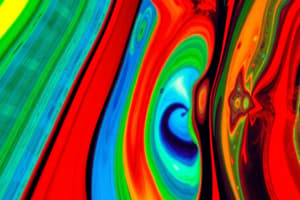Podcast
Questions and Answers
Which field is NOT typically involved in the study of sensation and perception?
Which field is NOT typically involved in the study of sensation and perception?
- Psychology
- Linguistics
- Astronomy (correct)
- Neuroscience
What technique is used to visualize brain activity in the study of sensation and perception?
What technique is used to visualize brain activity in the study of sensation and perception?
- Electroencephalography (EEG)
- Computed Tomography (CT)
- Positron Emission Tomography (PET) (correct)
- Magnetic Resonance Imaging (MRI)
Which method involves studying individuals with brain damage to understand sensation and perception?
Which method involves studying individuals with brain damage to understand sensation and perception?
- Patient studies (correct)
- Neuroimaging
- Brain stimulation
- Threshold assessment
What is the scientific term used for finding the limits of what can be perceived?
What is the scientific term used for finding the limits of what can be perceived?
Which of the following is a technique used to stimulate the brain during studies of sensation and perception?
Which of the following is a technique used to stimulate the brain during studies of sensation and perception?
What is the primary focus of psychophysics?
What is the primary focus of psychophysics?
Which method involves adjusting a stimulus until it is perceived?
Which method involves adjusting a stimulus until it is perceived?
What does the Absolute Threshold refer to in psychophysics?
What does the Absolute Threshold refer to in psychophysics?
Which psychophysical method involves using a range of stimuli for testing?
Which psychophysical method involves using a range of stimuli for testing?
What characterizes the Staircase Method in psychophysics?
What characterizes the Staircase Method in psychophysics?
Flashcards are hidden until you start studying
Study Notes
Dawn of Psychophysics
- Psychophysics studies the relationship between physical stimuli and psychological responses.
- Gustav Fechner is considered the founder of experimental psychology, creating the field of psychophysics.
Psychophysics adopted several new concepts for understanding sensation and perception
- Absolute threshold: The minimum amount of stimulation necessary to detect a stimulus 50% of the time.
- Method of limits: Start at one extreme and make way to the other end to find the threshold.
- Method of Adjustment: Adjust stimulus using dial or buttons until it is perceived, 50% of the time.
- Method of Constant Stimuli: Multiple stimuli covering a range are presented repeatedly, and the proportion of times each is detected is recorded. This tedious method creates a psychometric function.
- Staircase Method: The intensity of the stimulus is increased or decreased based on the previous trial response, finding the 50% detection point.
Fundamentals of Sensation and Perception
- Psychologists study sensation and perception using scientific methods, including measuring thresholds, scaling, sensory neuroscience, neuroimaging, and patient studies.
Measuring Thresholds
- Difference Threshold: The smallest change in a stimulus that can be detected 50% of the time (also known as just noticeable difference or JND).
Weber's Law
- Weber's law states that the JND is a constant proportion of the stimulus level. This means the difference threshold is relative to the intensity of the original stimulus.
Psychophysical Scaling
- Fechner's Law: The perceived intensity of a stimulus increases logarithmically with the physical intensity of the stimulus.
- Stevens' Law: The perceived intensity of a stimulus can be described by a power function, where the exponent varies across different sensory modalities.
Noise in Responses
- Noise refers to variability in neural responses, which can affect detection.
Signal Detection Theory
- This theory considers decision-making in perception, accounting for internal biases and sensitivity to the environment. The theory describes four possible outcomes of signal detection:
- Hit: Signal present, observer responds "yes"
- Miss: Signal present, observer responds "no"
- False Alarm: Signal absent, observer responds "yes"
- Correct Rejection: Signal absent, observer responds "no"
Receiver Operating Characteristic (ROC)
- The ROC curve plots the hit rate against the false alarm rate, showing how well an observer distinguishes signal from noise.
- A good performance is indicated by a curve that "bows out" towards the upper left corner, indicating a high hit rate with few false alarms.
Sensitivity, Criterion, and Bias
- Sensitivity: A measure of how easily an observer can distinguish between the presence and absence of a stimulus.
- Criterion: The internal threshold an observer sets for deciding when to report a stimulus.
- Bias: An observer's tendency to be liberal or conservative in responding, influenced by the criterion setting.
Studying That Suits You
Use AI to generate personalized quizzes and flashcards to suit your learning preferences.



